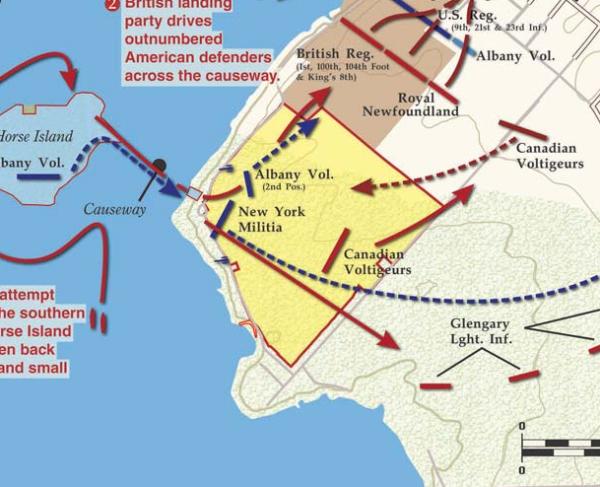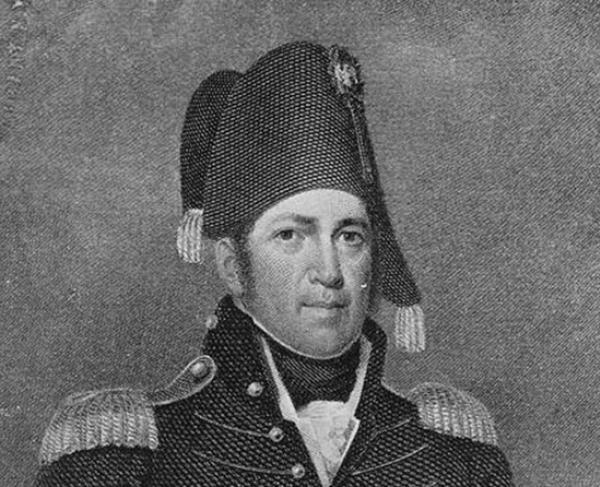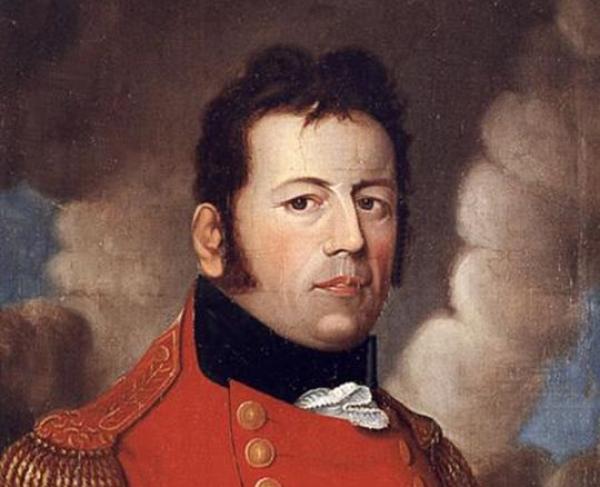
Battle of Sackets Harbor by Hiram Peabody Flagg.
Sackets Harbor
Second Sackets Harbor
New York | May 29, 1813
When war broke out between Britain and the United States, both sides began building up their naval forces on the Great Lakes. The lakes were vital highways for troops and supplies in the wilderness of the Old Northwest, so a naval arms race quickly overtook the region. While the two squadrons were equal, neither side was willing to risk a decisive battle, so most fighting in the region settled into a pattern of small skirmishes and raids.
After American forces on Lake Ontario tried to break the stalemate by attacking a British shipyard at the small town of York (now Toronto), the British decided to launch their own raid on Sackets Harbor – the main US shipyard on Lake Ontario. At the time of the raid, the Americans were building a sloop-of-war named General Pike that could have tipped the balance in their favor. When the British received news that many of the American ships and soldiers had left port to attack a British fort, leaving Sackets Harbor vulnerable, they seized the chance to strike.
Gen. Sir George Prevost, Governor General of Canada, personally took command of the raiding party. He hastily assembled a half-dozen ships, 900 British and Canadian soldiers, and a small party of Native American warriors at Kingston – the main British base on Lake Ontario. After a detour on May 28 to capture 150 American reinforcements traveling to the fort, Prevost began landing soldiers on May 29, 1813.
The Americans had expected a British attack for months, and had reinforced the town with earthwork fortifications, artillery, and blockhouses. There were about 1,500 soldiers present: about two-thirds volunteer militiamen, and the rest US regulars. Gen. Jacob Brown of the New York militia was the senior American officer present, and deployed the regulars in the town’s defenses and the militia outside the perimeter in order to oppose the British landing.
Prevost’s troops made landfall on Horse Island, which sat about a mile west of the town. Militiamen from Albany were waiting for them, but could not inflict enough casualties to stop the landing party. The growing number of British and Canadian infantrymen forced the New Yorkers to fall back across the causeway connecting Horse Island to the mainland, and after mustering their forces, the British followed them across.
Fortunately for the Americans, contrary winds prevented most of the British squadron from joining the fight. Without their heavy guns to weaken the American defenses, Prevost’s outnumbered forces were unable to move the American regulars along most of the town’s defenses. Gen. Brown was able to rally the panicked militiamen, and their added numbers allowed the Americans to flank the British forces. Fearing that his retreat would be cut off, Prevost called off his attack and ordered his men back to the boats.
Despite his defeat, however, Prevost’s attack panicked Americans in the shipyard, who set fire to their naval stores and ships so the British could not capture them. The fires aboard the General Pike were put out before much damage was done, but the loss of naval stores was very costly. At the end of the day, the Americans had defeated the British only to help them partially achieve their objective.
The battle hurt Prevost’s reputation with the British high command, and enhanced Brown’s reputation (earning him a general’s commission in the regular army). The General Pike did briefly help the Americans achieve superiority on Lake Ontario when it crippled the British flagship, but even this was short-lived. The stalemate continued as the British and Americans continued building larger and larger warships – eventually producing some of the largest warships in the world.
Sackets Harbor: Featured Resources
All battles of the St Lawrence and Lake Champlain Frontier Campaign
Est. Casualties: 795
United States: 320
United Kingdom: 475
United States: 307
United Kingdom: 265
Related Battles
1,400
870
307
265







